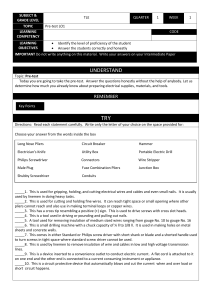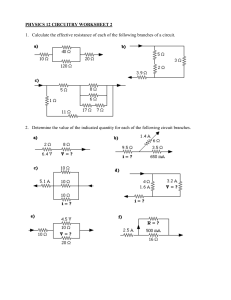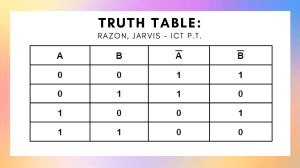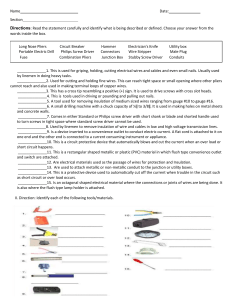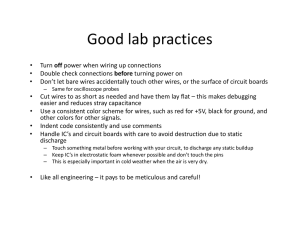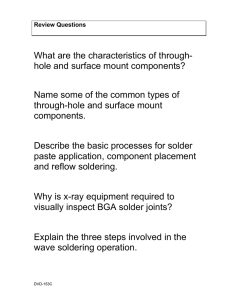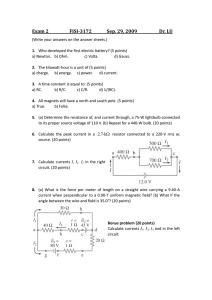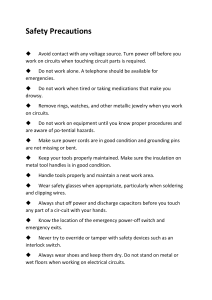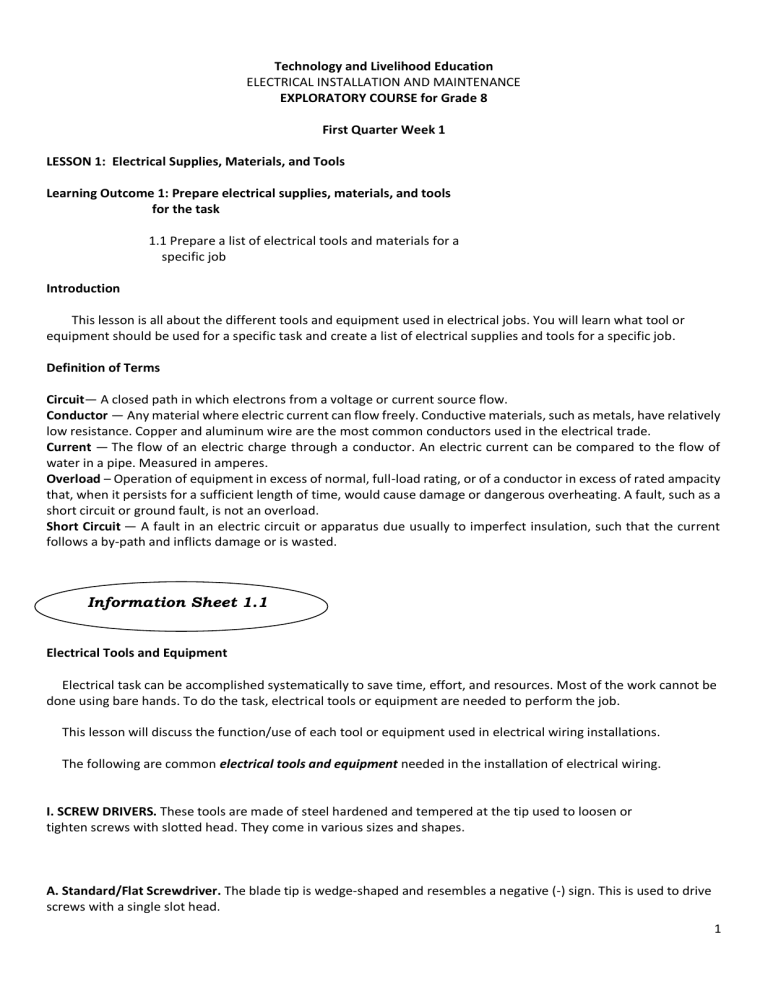
Technology and Livelihood Education ELECTRICAL INSTALLATION AND MAINTENANCE EXPLORATORY COURSE for Grade 8 First Quarter Week 1 LESSON 1: Electrical Supplies, Materials, and Tools Learning Outcome 1: Prepare electrical supplies, materials, and tools for the task 1.1 Prepare a list of electrical tools and materials for a specific job Introduction This lesson is all about the different tools and equipment used in electrical jobs. You will learn what tool or equipment should be used for a specific task and create a list of electrical supplies and tools for a specific job. Definition of Terms Circuit— A closed path in which electrons from a voltage or current source flow. Conductor — Any material where electric current can flow freely. Conductive materials, such as metals, have relatively low resistance. Copper and aluminum wire are the most common conductors used in the electrical trade. Current — The flow of an electric charge through a conductor. An electric current can be compared to the flow of water in a pipe. Measured in amperes. Overload – Operation of equipment in excess of normal, full-load rating, or of a conductor in excess of rated ampacity that, when it persists for a sufficient length of time, would cause damage or dangerous overheating. A fault, such as a short circuit or ground fault, is not an overload. Short Circuit — A fault in an electric circuit or apparatus due usually to imperfect insulation, such that the current follows a by-path and inflicts damage or is wasted. Information Sheet 1.1 Electrical Tools and Equipment Electrical task can be accomplished systematically to save time, effort, and resources. Most of the work cannot be done using bare hands. To do the task, electrical tools or equipment are needed to perform the job. This lesson will discuss the function/use of each tool or equipment used in electrical wiring installations. The following are common electrical tools and equipment needed in the installation of electrical wiring. I. SCREW DRIVERS. These tools are made of steel hardened and tempered at the tip used to loosen or tighten screws with slotted head. They come in various sizes and shapes. A. Standard/Flat Screwdriver. The blade tip is wedge-shaped and resembles a negative (-) sign. This is used to drive screws with a single slot head. 1 B. Philips Screwdriver. This has a cross tip resembling a positive (+) sign. This is used to drive screws with cross slot heads. C. Stubby Screwdriver. It comes in either Standard or Philips screwdriver with short shank or blade and a shorted handle used to turn screws in tight space where standard screwdriver cannot be used. D. Allen Screwdriver/Wrench. This could be in the shape of a screwdriver or a wrench. Its function is to drive screw with hexagonal slot head. II. HAMMERS. These are tools used in driving or pounding and pulling out nails and other fasteners into materials such as wood or dry wall. They are made of hard steel, wood, plastic, or rubber. A hammer has a head and a handle, or shaft. A. Claw Hammer. A tool primarily used for driving or pulling out nails from some other objects. 2 B. Mallet. A kind of hammer which is often made of rubber or sometimes wood. It can be used on sheet metal, wood working and upholstery. C. Ball Peen Hammer. Commonly used for rounding the edges of metal pins and fasteners, closing rivets, and shaping metal. III. PLIERS. These made from metal with insulators in the handle and are used for cutting, twisting, bending, holding, and gripping wires and cables. A. Combination Pliers (Lineman’s Pliers). This is used for gripping, holding, and cutting electrical wires and cables and even small nails. They are usually used by linemen in doing heavy tasks. B. Side Cutting Pliers. This type of pliers is used for cutting fine, medium, and big wires and cables. C. Long Nose Pliers. This is used for cutting and holding fine wires. This can reach tight space or small opening where other pliers cannot reach and also used in making terminal loops of copper wires. IV. Wire Stripper. A tool used for removing insulation of medium sized wires ranging from gauge #10 to gauge #16. 3 V. Electrician’s Knife. This is used by linemen to remove insulation of wire and cables in low and high voltage transmission lines. VI. Portable Electric drill. A small equipment with a chuck capacity of ¼” to 3/8”. It is used in making holes on metal sheets and concrete walls. VII. Hacksaw. This tool is used to cut metal conduit and armored cable. Electrical Supplies and Materials Electrical materials are developed and constructed for a special purpose such as to: 1. Control the flow of current in an electrical circuit; 2. Carry electrical current from the source to the load or current consuming apparatus; 3. Hold and secure wires to its fixtures inside and outside houses and buildings; and 4. Protect the houses, buildings, appliances’ and instruments from any destruction and damage. 4 Convenience outlet- is a device that acts as convenient source of electrical energy for current consuming appliances. It is where the male plug of an appliance is inserted and usually fastened on the wall or connected in an extension cord. It maybe single, duplex, triplex or multiplex and could be surface type or flush type. Male plug- a device inserted to a convenience outlet to conduct electric current. A flat cord is attached to it on one end and the other end is connected to a current consuming instrument or appliance. Lamp holders- are devices that hold and protect the lamp and are also called as ―”Lamp Sockets/Receptacles”. These come in many designs and sizes. They are classified as flush, hanging (weatherproof/chain) and surface types. Switch - a device that connects and disconnects the flow of electric current in a circuit. There are many shapes, designs, and types and they are classified as hanging, flush, and surface types. Fuse - a circuit protective device that automatically blows and cut the current when and overload or short circuit happens. Circuit Breaker - is a protective device used to automatically cut off the current when there is a trouble in the circuit such as short circuit or over load occurs. 5 Junction Box - an octagonal shaped electrical material where connections or joints of wires are being done. It is also where the flush type lamp holder is attached. This could be made of metal or plastic (PVC) Polyvinylchloride. Utility Box - a rectangular shaped metallic or plastic (PVC) material in which flush type convenience outlet and switch are attached. Flat Cord- Is a duplex stranded wire used for temporary wiring installation and commonly used in extension cord assembly. It comes in a roll of 150 meters and with sizes of gauge # 18 and gauge # 16 AWG. Electrical Wire/Conductor- electrical material that could be: a. Stranded wire which is made of multiple strands joined together to make a single wire. Stranded wire is more flexible than solid wire of the same total cross-sectional area. b. Solid wire is made of a single strand of copper or aluminum wire. These are used in wiring installation inside and outside the buildings. Solid wire is cheaper to manufacture than stranded wire and is used where there is little need for flexibility in the wire. 6 Conduits- electrical materials used as the passage of wires for protection and insulation. These could be rigid metallic, flexible metallic conduit (FMC),rigid nonmetallic (PVC), and flexible non-metallic or corrugated plastic conduit (CPC). Clamps- electrical materials used to hold and anchor electrical conduits in its proper position. Connectors- used to attach metallic or non-metallic conduit to the junction or utility boxes. Eyelet Wire Connectors- are installed on the ends of wires so that they can be securely connected to equipment using bolt or screw. 7 Technology and Livelihood Education ELECTRICAL INSTALLATION AND MAINTENANCE EXPLORATORY COURSE for Grade 8 First Quarter Week 1 Name of Learner: ____________________________________ Grade Level: _________________________ Section: ____________________________________ Date: _________________________ Activity 1.1 Preparing List of Materials and Tools Directions: You will be given a scenario wherein you have to perform simple electrical jobs. List down the materials and their estimated quantities, and the tools you will need to perform the task. Scenario You were given a task to make 10 samples of different electrical splices and joints by your teacher in TLE. List the down the tools and materials that you will need to perform the task including their estimated quantities and costs on the table below. Electrical Splices and Joints- joining of wires in electrical wiring Materials: Qty. Unit Description Unit Cost Total Cost Total Cost of Materials 8 Tools: Tool name/Description 1. 2. 3. 4. 5. 6. Post-Test 1.1 A. Directions: Identify each of the following electrical tools and materials. Write your answers in the opposite box of each picture. Tools/Materials Name 1. 2. 3. 4. 5. 6. 9 7. 8. 9. 10. 11. 12. 13. 14. 15. B. Directions: Read and understand each description carefully. Identify the tool or material which is being described in each item. Write the letter of the correct answer on the blank provided before each item. a. Long Nose Pliers b. Electrician’s Knife c. Philips Screwdriver d. Male Plug e. Pliers f. Utility box g. Connectors h. Fuse i. Circuit Breaker j. Portable Electric Drill k. Wire Stripper l. Combination Pliers m. Claw Hammer n. Stubby Screwdriver o. Conduits p. Junction Box 10 ___________1. It is used for griping, holding, cutting electrical wires and cables and even small nails, and usually used by linemen in doing heavy tasks. ___________2. This tool is used for cutting and holding fine wire, can reach tight space or small opening where other pliers cannot reach, and used in making terminal loops of copper wires. ___________3. This has a cross tip resembling a positive (+) sign. It is used to drive screws with cross slot heads. ___________4. This is tools used in driving or pounding and pulling out nails. ___________5. A tool used for removing insulation of medium sized wires ranging from gauge #10 to gauge #16. ___________ 6. A small equipment with a chuck capacity of 1/4” to 3/8”. It is used in making holes on metal sheets and concrete walls. ___________7. A type of screwdriver with short shank or blade and shorted handle used to turn screws in tight spaces. ___________8. Used by linemen to remove insulation of wire and cables in low and high voltage transmission lines. ___________9. Is a device inserted to a convenience outlet to conduct electric current. A flat cord is attached to it on one end and the other end is connected to a current consuming instrument or appliance. ___________10. This is a circuit protective device that automatically blows and cut the current when an overload or short circuit happens. ___________11. This is a rectangular shaped metallic or plastic (PVC) material in which flush type convenience outlet and switch are attached. ___________12. Are electrical materials used as the passage of wires for protection and insulation. ___________13. Are used to attach metallic or non-metallic conduit to the junction or utility boxes. ___________14. This is a protective device used to automatically cut off the current when there is a trouble in the circuit such as short circuit or overload occurs. ___________15. Is an octagonal shaped electrical material where the connections or joints of wires are done. It is also where the flush type lamp holder is attached. C. Directions: You will be given a scenario wherein you have to perform simple electrical jobs. List down the materials and their estimated quantities, and the tools you will need to perform the task. Scenario You are planning to make an extension cord to be used in your study table wherein you should be able to plug in two electrical devices at the same time. The distance from your study table to the convenience outlet where you will plug in the extension cord is 3 meters. List the down the tools and materials that you will need to perform the task including their quantities on the table below. 11 Materials: Qty. Unit Description Unit Cost Total Cost Total Cost of Materials Tools: Tool name/Description 1. 2. 3. 4. 5. 6. References: K to 12 Basic Education Curriculum Technology and Livelihood Education Learning Module Electrical Installation and Maintenance Exploratory Course for Grade 7 and 8 Module Writers: HECTOR M. VALLARTA/ ROMAN A. CABUSORA JR. 12
